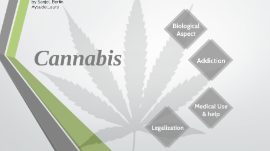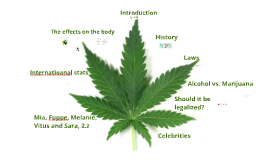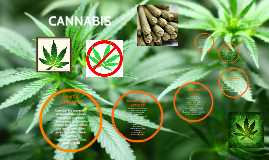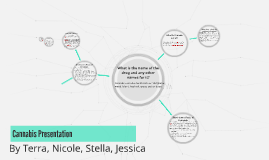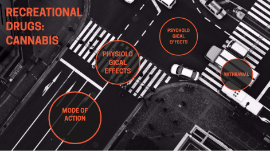Cannabis Presentation
Transcript: Cannabis Presentation By Axel, Mady and Ben What is Cannabis? Cannabis and It's Effects Cannabis, which is also known as marajuanna or weed (among other things), is a product of the cannabis or hemp plant that is used for its psychoactive and therapeutic effects. It comes in many forms, including as dried flowers and leaves; hash; extracts and shatter; and edibles (e.g., candies, butter or baked goods). More than 100 chemicals, called cannabinoids, have been identified as specific to the cannabis plant. THC is the main psychoactive cannabinoid and is most responsible for the “high” associated with cannabis use. According to the Canadian Tobacco, Alcohol and Drugs Survey, 27% of Canadians use cannabis recreationally as of 2022. The Effects of Cannabis The Effects of Cannabis Cannabis can have a different effect on everyone. The effect it has on you depends on how you take it(smoking, vaping, edibles, ect.), how much you use, how long you've been using cannabis, and many other variables. You may feel relaxed, lively, talkative, giggly and even euphoric, or it can make you feel tense, anxious, fearful and confused. The kind of experience you may have can vary from one time to another, usually because of the amount taken, the method used and how often you use it. Physical Effects of Cannabis Some physical effects of cannabis use include red/dry eyes, dry month, increase in heart rate and/or appitite, decrease in blood preasure, ballance and/or stability. Symptoms and Medical Uses Medical Uses for Cannabis Some Medical Uses for Cannabis Cannabis can be used to regulate/manage symptoms from several medical conditions. Some of these symptoms are nausea, pain, seizures, depression, insomnia, among other things. Cannabis is used to treat conditions such as Alzheimers desease, ALS, HIV/AIDS, Crohns desease, Epilepsy, and severe chromic pain. Types of Cannabis There are 2 main species of cannabis, indica and sativa. Both are used for several reasons, both medical and recreational. Recently, a third species, called ruderalis, has also been discovered. There are also hybrid strains which are made up of a mix of the 2 major species. Types of Cannabis Indica vs Sativa Indica Vs. Sativa Hybrids Hybrid strains are made by cross breeding 2 different strains of Cannabis in an attempt to produce effects of both. Most of the strains that are commonly grown today are hybrids rather than pure indica or sativa. Hybrids Pros and Cons of Using Cannabis Pros: - Pain Relief - Inproved sleep - Reduced nausea/vomitting -Improved appitite -Helps treat many illnesses -Prevents seizures -Lowers blood pressure The Pros and Cons of Using Cannabis Cons: -Breathing problems -Increased heartrate -Problems with development with children during and after pregnancy -Headaches -Fatigue -Memory Loss Paranoia Conclusion People use cannabis for many different reasons, both medically and recreationally. It has good and bad side effects, just like anything else. As long as you use it safely and you are of legal age to use it, it can be very benificial to ones mental and physical health. Conclusion







